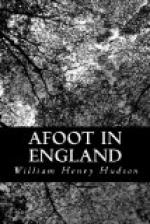Now we know, our reason tells us continually, that the mental pictures formed in childhood are false because the child and man have different standards, and furthermore the child mind exaggerates everything; nevertheless, such pictures persist until the scene or object so visualized is actually looked upon and the old image shattered. This refers to scenes visualized with the inner eye, but the disillusion is almost as great when we return to a home left in childhood or boyhood and look on it once more with the man’s eyes. How small it is! How diminished the hills, and the trees that grew to such a vast height, whose tops once seemed “so close against the sky”—what poor little trees they now are! And the house itself, how low it is; and the rooms that seemed so wide and lofty, where our footfalls and childish voices sounded as in some vast hall, how little and how mean they look!
Children, they are very little,
the poet says, and they measure things by their size; but it seems odd that unless we grow up amid the scenes where our first impressions were received they should remain unaltered in the adult mind. The most amusing instance of a false picture of something seen in childhood and continuing through life I have met was that of an Italian peasant I knew in South America. He liked to talk to me about the cranes, those great and wonderful birds he had become acquainted with in childhood in his home on the plains of Lombardy. The birds, of course, only appeared in autumn and spring when migrating, and passed over at a vast height above the earth. These birds, he said, were so big and had such great wings that if they came down on the flat earth they would be incapable of rising, hence they only alighted on the tops of high mountains, and as there was nothing for them to eat in such places, it being naked rock and ice, they were compelled to subsist on each other’s droppings. Now it came to pass that one year during his childhood a crane, owing to some accident, came down to the ground near his home. The whole population of the village turned out to see so wonderful a bird, and were amazed at its size; it was, he said, the strangest sight he had ever looked on. How big was it? I asked him; was it as big as an ostrich? An ostrich, he said, was nothing to it; I might as well ask him how it compared with a lapwing. He could give me no measurements: it happened when he was a child; he had forgotten the exact size, but he had seen it with his own eyes and he could see it now in his mind—the biggest bird in the world. Very well, I said, if he could see it plainly in his mind he could give some rough idea of the wing-spread—how much would it measure from tip to tip? He said it was perhaps fifty yards—perhaps a good deal more!




